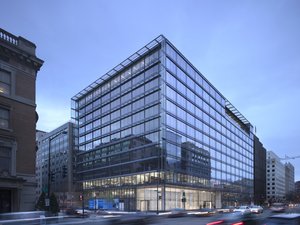
Washington, D.C., could very well become a hub for virtual reality (VR) innovation in the coming years.
Even though the VR revolution is in many ways just getting started, many of the qualities and assets necessary to compete in the VR industry are already held by local businesses. In fact, Maryland is recognized as the birthplace of virtual reality on the East Coast. And that truth, though it may be surprising for most, is important given the market potential of the industry.
We've been taking a look at why the D.C.-area could be positioned to reap some major benefits as the VR economy picks up steam, which we'll be covering here. In Part 2, we plan to show how the area can keep momentum.
Hello Oculus
In March 2014, Facebook announced the $2 billion acquisition of VR tech startup Oculus, led by University of Maryland alum Brendan Iribe. Many have called the acquisition a watershed moment for virtual reality—a massive vote of confidence in the VR industry’s consumer potential.
Then last September, Iribe returned to the D.C. area to announce a $31 million donation to fund a new tech center at UMd, the Brendan Iribe Center for Computer Science and Innovation. The center, according to UMd Institute for Advanced Computer Studies director Amitabh Varshney, will be located on college drive—near its main entrance—and be finished within three years.
Varshney will be teaching UMd’s first ever VR course in the Spring of 2016, where they will be developing software through the Unity Game Engine. Varshney said the class was only viable because of the money donated by Iribe and because VR technology has become progressively cheaper. “Not too long ago VR headsets, designed for industrial clients, cost $8,000. That made teaching a course like this impossible. As you can imagine, a classroom environment is a tough place.”
Much like the Facebook acquisition and its influence on the industry, Iribe’s UMd donation has made waves, sounding a call to action locally in VR.
Perhaps unsurprisingly, however, predicting the future market potential of virtual reality is a difficult thing to do.
With the impending launch of a series of competing VR headsets by a number of major consumer electronics giants like Sony, Microsoft, Facebook and HTC/Valve, the public will soon get its first real dose of consumer virtual reality. But that experience is difficult to quantify into a dollar total—especially when one begins to consider the opportunities offered via a VR platform to advertisers and other content creators.
Prominent market research and investment consultancy firms have recently floated figures that range between $5.2 billion by 2018 and $150 billion by 2020.
Regardless of the potential size, many investors and analysts are buying into the commercial opportunities that VR will likely provide in the future. And as with any impending tsunami of cash, a large group of related companies, investors and entrepreneurs are working against the clock—in what resembles a 21st Century gold rush—to claim a piece of that pie.

Capitol innovation
The DMV is home to a number of industry leading gaming studios, many of whom are already experimenting with VR for upcoming gaming consoles. These studios—like Bethesda Softworks and Firaxis—have proven they can market and successful sell video games. Their next step will be to dominate the VR video gaming sphere—perhaps the technology’s first massive consumer frontier.
At the center of local VR innovation sit a handful of notable companies, that include longstanding Columbia, Md.-based VR headset and software maker Sensics; College Park-based true 3D audio developer VisiSonics (operating from UMd's incubator space); Towson-based media studio Bully Entertainment; D.C.-based VR environment creator AgoraVR; and D.C.-based Primrose Editor, among others.
(Above video: AMG Performance Center - Oculus Rift Modular Dealership Component Presentation from Bully Entertainment)
In September, VisiSonics signed a major contract to become the official SDK audio tech provider for Oculus. In about three months, VisiSonics CEO Gregg Wilkes said he expects to raise a roughly $2 million Series A round.
Meanwhile, Sensics, founded in 1999, is something akin to the godfather of the D.C. VR movement. The company is led by virtual reality pioneer and CEO Yuval Boger. They are the longest standing local VR company and command funding support that is superior to all of its peers, with just VisiSonics and Bully Entertainment also being mature companies.
Sensics is a truly unique VR company because instead of specializing in a specific VR product, they have developed everything that goes into a headset, including the display panels, audio technology and motion tracking sensors.
Boger’s VR empire has raised more than $3 million and is currently in the process of raising at least another $1.5 million, he told DC Inno in an interview. Existing investors include Longstreet Partners, Athlone Global Security, the Maryland Department of Business and Economic Development and the Maryland Technology Development Corporation.
Sensics, which originated in the halls of Johns Hopkins University as a young group of developers who were working on a medical VR-enabled application, is also responsible for being one of the first companies to sell virtual reality products in the DMV.
Their early local experience in the space can be taken as a metaphor for how the nascent VR market is changing.
The company’s early clients were industrial and defense-related clients based primarily in Virginia, many of whom used VR technology to build virtual training simulations and for engineering purposes—where schematics were complex and/or troublesome. But Boger told DC Inno that business via these government-funded clients could be inconsistent.
The shift to consumer
“As with the Internet, a great deal of early VR innovation was driven by government funding in the DMV region. So much of what has been funded locally, including VisiSonics 3D audio solutions, is now attracting the attention of companies taking advantage of the convergence of mobile tech that makes this whole new generation of consumer VR devices possible,” Eugene Evans, CEO of D.C.-based media startup GoPop.TV and a senior advisor to VisiSonics, told DC Inno.
With the proliferation of consumer VR on the horizon, Boger agreed with Evans, that he fully expects a ramp up in sales. A rising tide lifts all boats
“Consumers are the missing piece at the moment. Virtual reality has the potential to affect every aspect of how we do business and if companies don't begin exploring these opportunities they are going to be left behind,” AgoraVR co-founder Matthias McCoy-Thompson added.
With VR, Boger explained, it’s all about the experience. You need to try on the headsets and see what the technology can offer—clever advertising, no matter how viral, cannot do it justice—and as such, the overall VR industry will stand to benefit from an increase in expose via in-store/retail sales. Which, as implied, will hopefully equate to greater demand across the board.
Interestingly, Sensics is also a lead author of the OSVR initiative, a mission that hopes to make virtual reality design schematics and developer code open-sourced. The idea is to drive innovation as quickly possible through a crowdsourcing of information. And Boger told DC Inno that the project is gaining steam. Razer, a large Singapore-based gaming tech company that develops gaming products, hardware and software, recently signed on to become an OSVR partner. Gearbox Software, Sixense, Leap Motion and Nod, are also all OSVR partners.
Sensics is currently working on one project, a medical application that’s in trials at Johns Hopkins, to help low-vision patients. “VR is not just about gaming, in a professional market, as it’s always been here, we see a lot of growth opportunities even outside of gaming,” Boger said.
The next generation of innovators
From a community standpoint, the D.C. VR scene is currently defined by a single large grassroots club called the DC Virtual Reality meetup group, which is organized by AgoraVR founders Jason Ganz and McCoy-Thompson. It’s made up of hundreds of enthusiasts and developers who are creating and sharing ideas about interesting VR projects.
And while there are a few local VR companies and startups (mentioned previously), people are generally waiting until they can turn VR development into a full-time endeavor before committing to it. As is the case nationally, passionate and talented individuals who are working on VR projects lack the resources to turn them into self-sustaining companies. Companies like Sensics and VisiSonics are an exception rather than the standard.
“I'd say it's very similar to the drone community right now—a lot of enthusiasts, a few entrepreneurs, and a couple larger companies looking to get their toes wet,” Ganz said.
When investor change this dynamic—via an influx of capital based on honest confidence in future returns—then that’s when we’ll see an acceleration in innovation, Ganz described.

In June, TechCrunch reported that Mountain View, Calif.-based Matterport, which has developed a camera that scans rooms and turns them into 3D environments, raised a stunning $30 million Series C. Then one month later, another Calif.-based company called AltspaceVR, the creators of a virtual reality chatroom, raised an impressive $10 million Series A.
Investor attitudes are changing, even while AgoraVR, Sensics, Primrose and VisiSonics’ executives told DC Inno that the investment atmosphere is more conservative, locally. The general shift is a positive sign of whats to come.
In the background of UMd's rising VR program and the stark monument lights of D.C., a growing community is already forming itself around the nascent industry. The DCVR group has worked with organizations from Maker Faire to the Boys and Girls Club to show off the power of virtual reality and demonstrate how it may affect society in the future.
Among the achievements that've come from group members: DCVR member and indie game developer David Busch recently won an award from VisiSonics for making a game demonstrating their tech; member Joe Bass is working to build a fully-featured smartphone-based VR viewer out of his garage; and Highland FRS CTO and local VR enthusiast turned developer Sean McBeth is the creator of Primrose Editor, a programming environment that runs in VR, in a Web browser.
“The DCVR Meetup group is one of the best in the area, with frequent, high-quality events and an excellent atmosphere of accessibility,” McBeth told DC Inno. "Without them, we wouldn't even be having this conversation right now."
We're planning to post Part 2 early next week.




